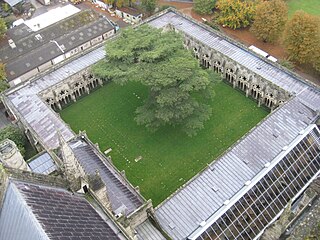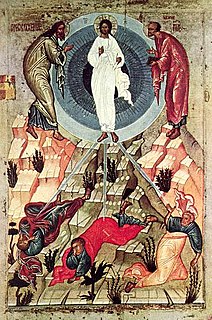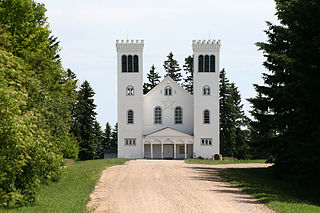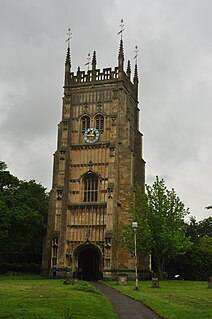Related Research Articles

Benedict of Nursia was a Christian saint venerated in the Catholic Church, the Eastern Orthodox Church, the Oriental Orthodox Churches, the Anglican Communion and Old Catholic Churches. He is a patron saint of Europe.

Pachomius, also known as Saint Pachomius the Great, is generally recognized as the founder of Christian cenobitic monasticism. Coptic churches celebrate his feast day on 9 May, and Eastern Orthodox and Roman Catholic churches mark his feast on 15 May or 28 May. In the Lutheran Church, he is remembered as a renewer of the church, along with his contemporary, Anthony of Egypt on January 17.

Monte Cassino is a rocky hill about 130 kilometres (80 mi) southeast of Rome, in the Latin Valley, Italy, 2 kilometres west of Cassino and at an elevation of 520 m (1,710 ft). Site of the Roman town of Casinum, it is widely known for its abbey, the first house of the Benedictine Order, having been established by Benedict of Nursia himself around 529. It was for the community of Monte Cassino that the Rule of Saint Benedict was composed.

A monastery is a building or complex of buildings comprising the domestic quarters and workplaces of monastics, monks or nuns, whether living in communities or alone (hermits). A monastery generally includes a place reserved for prayer which may be a chapel, church, or temple, and may also serve as an oratory, or in the case of communities anything from a single building housing only one senior and two or three junior monks or nuns, to vast complexes and estates housing tens or hundreds. A monastery complex typically comprises a number of buildings which include a church, dormitory, cloister, refectory, library, balneary and infirmary, and outlying granges. Depending on the location, the monastic order and the occupation of its inhabitants, the complex may also include a wide range of buildings that facilitate self-sufficiency and service to the community. These may include a hospice, a school, and a range of agricultural and manufacturing buildings such as a barn, a forge, or a brewery.

The calendar of saints is the traditional Christian method of organizing a liturgical year by associating each day with one or more saints and referring to the day as the feast day or feast of said saint. The word "feast" in this context does not mean "a large meal, typically a celebratory one", but instead "an annual religious celebration, a day dedicated to a particular saint".

Saint-Émilion is a commune in the Gironde department in Nouvelle-Aquitaine in southwestern France. In 2016, it had a population of 1,938.

A cloister is a covered walk, open gallery, or open arcade running along the walls of buildings and forming a quadrangle or garth. The attachment of a cloister to a cathedral or church, commonly against a warm southern flank, usually indicates that it is part of a monastic foundation, "forming a continuous and solid architectural barrier... that effectively separates the world of the monks from that of the serfs and workmen, whose lives and works went forward outside and around the cloister."

Christian monasticism is the devotional practice of Christians who live ascetic and typically cloistered lives that are dedicated to Christian worship. It began to develop early in the history of the Christian Church, modeled upon scriptural examples and ideals, including those in the Old Testament, but not mandated as an institution in the scriptures. It has come to be regulated by religious rules and, in modern times, the Canon law of the respective Christian denominations that have forms of monastic living. Those living the monastic life are known by the generic terms monks (men) and nuns (women). The word monk originated from the Greek μοναχός, itself from μόνος meaning 'alone'.
Saint Ecgberht was an Anglo-Saxon monk of Northumbria. After studying at Lindisfarne and Rath Melsigi, he spent his life travelling among monasteries in northern Britain and around the Irish Sea. He was instrumental in the establishment of Wihtberht's mission to Frisia.

John Cassian, also known as John the Ascetic and John Cassian the Roman, was a Christian monk and theologian celebrated in both the Western and Eastern churches for his mystical writings. Cassian is noted for his role in bringing the ideas and practices of early Christian monasticism to the medieval West.

Gerald of Mayo is a saint of the Roman Catholic Church and Eastern Orthodox Church. Born in Northumbria, the son of an Anglo-Saxon king, he was one of the English monks at Lindisfarne who accompanied Colmán of Lindisfarne to Iona and then to Ireland. This occurred after the Synod of Whitby 664AD which decided against the Irish method of calculating the date for Easter. Colman was an ardent supporter of the Irish traditions; after the synod decided to adopt the Roman computation.
In Christianity, an oblate is a person who is specifically dedicated to God or to God's service.

Lérins Abbey is a Cistercian monastery on the island of Saint-Honorat, one of the Lérins Islands, on the French Riviera, with an active monastic community.

The Paromeos Monastery, also known as Baramos Monastery, is a Coptic Orthodox monastery located in Wadi El Natrun in the Nitrian Desert, Beheira Governorate, Egypt. It is the most northern among the four current monasteries of Scetis, situated around 9 km northeast of the Monastery of Saint Pishoy. Ecclesiastically, the monastery is dedicated to and named after the Virgin Mary.

St. Peter's Abbey is in Muenster, Saskatchewan, Canada. It is the oldest Benedictine monastery in Canada. It was founded in 1903.

The Order of Saint Basil the Great, also known as the Basilian Order of Saint Josaphat, is a Greek Catholic monastic order of pontifical right that works actively among Ukrainian Catholics and other Greek-Catholic churches in central and eastern Europe.. The order received approbation on 20 August 1631, and is based at the Monastery of the Holy Trinity, Vilnius.
Zanitas and Lazarus of Persia were martyrs of the Christian church.

Saint Credan of Evesham is a saint in the calendar of the Roman Catholic Church and of the Eastern Orthodox Church. He is also known in Latin as Credus or Credanus.
The Monastery of Saint Maron, also called the Cave of the monks, is an ancient cavern initially developed as a refuge structure by the Romans and later used as a Maronite monastery - carved out of solid rock in the side of a cliff, located around 200 metres (660 ft) from Ain ez Zarqa, a source of the Orontes river, and south of Hermel in Baalbek-Hermel Governorate, northern Lebanon. It is named after Saint Maron whose life and works at the location is associated with the establishment of the Maronite Church.

The Mont-Saint-Michel Abbey is an abbey located within the city and island of Mont-Saint-Michel in Normandy, in the department of Manche.
References
- ↑ “Abrahamite Monks”. Saints.SQPN.com. 12 August 2012. Web. {2012-9-20}.
- ↑ Roman Martyrology